
The Lahore Fort is a citadel in the city of Lahore in Punjab, Pakistan. The fortress is located at the northern end of Walled city of Lahore and spreads over an area greater than 20 hectares. It contains 21 notable monuments, some of which date to the era of Emperor Akbar. The Lahore Fort is notable for having been almost entirely rebuilt in the 17th century, when the Mughal Empire was at the height of its splendor and opulence.
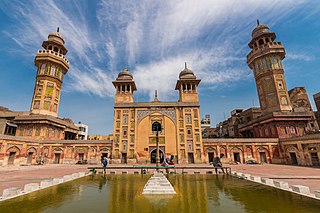
The Wazir Khan Mosque is a 17th-century mosque located in the city of Lahore, Punjab, Pakistan. The mosque was commissioned during the reign of the Mughal Emperor Shah Jahan as a part of an ensemble of buildings that also included the nearby Shahi Hammam baths. Construction of Wazir Khan Mosque began in 1634 C.E., and was completed in 1641. It is on the UNESCO World Heritage Tentative List.

Skardu is a city located in Pakistani-administered Gilgit−Baltistan in the disputed Kashmir region. Skardu serves as the capital of Skardu District and the Baltistan Division. It is situated at an average elevation of nearly 2,500 metres above sea level in the Skardu Valley, at the confluence of the Indus and Shigar Rivers. The city is an important gateway to the eight-thousanders of the nearby Karakoram mountain range. The Indus River running through the region separates the Karakoram from the Ladakh Range.

Mughal architecture is the type of Indo-Islamic architecture developed by the Mughals in the 16th, 17th and 18th centuries throughout the ever-changing extent of their empire in the Indian subcontinent. It developed from the architectural styles of earlier Muslim dynasties in India and from Iranian and Central Asian architectural traditions, particularly Timurid architecture. It also further incorporated and syncretized influences from wider Indian architecture, especially during the reign of Akbar. Mughal buildings have a uniform pattern of structure and character, including large bulbous domes, slender minarets at the corners, massive halls, large vaulted gateways, and delicate ornamentation; examples of the style can be found in modern-day Afghanistan, Bangladesh, India and Pakistan.

Baltit Fort is a fort in the Hunza valley, near the town of Karimabad, in the Gilgit-Baltistan region of northern Pakistan. Founded in the 8th century CE, it has been on the UNESCO World Heritage Tentative list since 2004.
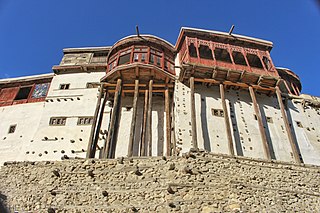
Karimabad, formerly known as Baltit, is the capital of the Hunza District in the Gilgit-Baltistan region of Pakistan.

The Hunza Valley is a mountainous valley in the northern part of the Gilgit-Baltistan region of Pakistan.

Altit Fort is an ancient fort in the Altit town in the Hunza valley in Gilgit Baltistan, Pakistan. It was originally home to the hereditary rulers of the Hunza state who carried the title of 'Mir', although they moved to the somewhat younger Baltit fort nearby three centuries later. Altit Fort and in particular the Shikari tower is around 1100 years old, which makes it the oldest monument in the Gilgit–Baltistan. The fort has received the UNESCO Asia Pacific Heritage Award for Cultural Heritage Conservation in 2011.
The Aga Khan Trust for Culture (AKTC) is an agency of the Aga Khan Development Network (AKDN), a family of institutions created by Aga Khan IV with distinct but complementary mandates to improve the welfare and prospects of people in the developing world, particularly in Asia and Africa. It focuses on the revitalization of communities in the Muslim world—physical, social, cultural, and economic. The AKTC was founded in 1988 and is registered in Geneva, Switzerland, as a private non-denominational philanthropic foundation.

Bagh-e Babur, also known as Gardens of Babur, is a historic site in Kabul, Afghanistan. It is located in the Sher Darwaza hillside of District 5, southwest of Shahr-e Naw, or a short distance south of Kabul Zoo and north of Chihil Sutun. The gardens of Babur has several terraced buildings, a small mosque, and plenty of walking space. Visited by up to one million locals and foreign tourists a year, it is also where the tomb of the first Mughal emperor Babur is located. The park is thought to have been developed around 1504, when Babur gave orders for the construction of an "avenue garden" in Kabul, described in some detail in his memoirs, the Baburnama. It has been re-developed by various Afghan rulers since then.

Ganish is a village in the Hunza District within the Gilgit Baltistan region of Pakistan. It is the oldest and first settlement on the ancient Silk Road in the Hunza Valley, and is the site of various ancient watchtowers, traditional mosques, religious centers, and a reservoir. It is located 90 km away from Gilgit. The word "Ganish" is unknown but according to the local scholars, it is derived from the Burushaski word "Genish" which means gold. Ganish has been a major town for travelers since the days of the Silk Road - now the Karakorum Highway.

Gilgit-Baltistan, formerly known as the Northern Areas, is a region administered by Pakistan as an administrative territory and consists of the northern portion of the larger Kashmir region, which has been the subject of a dispute between India and Pakistan since 1947 and between India and China since 1959. It borders Azad Kashmir to the south, the province of Khyber Pakhtunkhwa to the west, the Wakhan Corridor of Afghanistan to the north, the Xinjiang region of China to the east and northeast, and the Indian-administered union territories of Jammu and Kashmir and Ladakh to the southeast.

Shahid Akhtar Qalandar, commonly known by his stage name Qalandari, or Shahid Qalandar, is a Pakistani singer-songwriter born and raised in the Hunza Valley, Gilgit Baltistan, Pakistan.
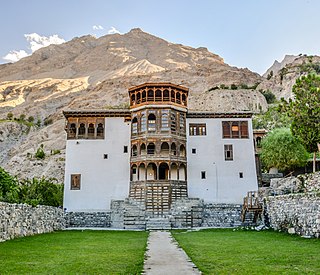
Khaplu Palace, locally known as Yabgo Khar, is an old fort and palace located in Khaplu, a city in Gilgit−Baltistan, Pakistan. The palace, considered an architectural heritage site and a significant tourist attraction, was built in the mid-19th century to replace an earlier-dated fort located nearby. It served as a royal residence for the Raja of Khaplu.
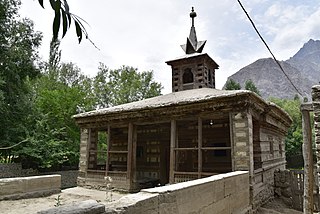
The Amburiq Masjid is a mosque located in Shigar, in the Gilgit-Baltistan region of Pakistan. It is one of the oldest mosques in Baltistan. The mosque was built by Sayed Ali Hamdani and is among the famous landmarks in Baltistan.
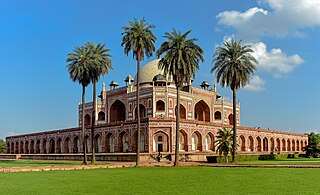
Ratish Nanda is a noted Indian conservation architect, who is the Projects Director of Aga Khan Trust for Culture, India.

Tourism in Gilgit-Baltistan, an administered territory of Pakistan, focuses on its access to various mountain ranges and alpine terrain.
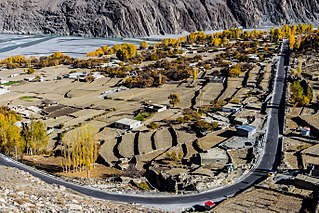
The Hunza District is a district of Pakistan-administered Gilgit-Baltistan in the disputed Kashmir region. Hunza district is one of the 14 districts of the Pakistani-administered province of Gilgit-Baltistan. It was established in 2015 by the division of the Hunza–Nagar District in accordance with a government decision to establish more administrative units in Gilgit-Baltistan. The district headquarters is the town of Karimabad.

The Shahi Hammam, also known as the Wazir Khan Hammam, is a Turkish bath which was built in Lahore, Pakistan, in 1635 C.E. during the reign of Emperor Shah Jahan. It was built by chief physician to the Mughal Court, Ilam-ud-din Ansari, who was widely known as Wazir Khan. The baths were built to serve as a waqf, or endowment, for the maintenance of the Wazir Khan Mosque.



















